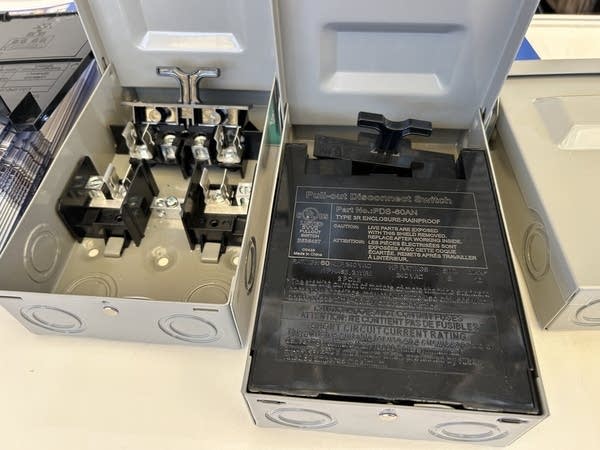The Xiangguang Hats company from China’s southern Guangdong province is one exporter able to expand beyond the U.S. market.
It started when President Donald Trump imposed tariffs on certain Chinese exports in 2018 during his first term. Xiangguang’s hats, which include baseball hats, trucker hats and cartoon bear hats with floppy ears, faced an extra 20% duties.
Back then, 40% of Xiangguang’s sales were to the U.S.
“But now, we sell mainly to South Africa, to big brands like supermarkets. So, our sales to the U.S. have dropped a lot — to about 15%,” Xiangguang owner, Wu Qizhen, told Marketplace at a recent Shanghai trade show.
The U.S. remains a major destination for Chinese exports but the market has been shrinking from 19% in 2018 to just under 15% last year.
Trade between the two countries is set to go down further. At the start of Trump’s second term, the president imposed sky-high tariffs on Chinese exports of 145%. The two sides have agreed to take a temporary pause while they hammer out a trade deal. The U.S. tariff rate on most Chinese goods has been temporarily reduced to 30%, plus existing duties. At the same time, China cut its retaliatory tariffs on American exports from 125% to 10%. This is on top of the 10% to 15% retaliatory duties on American products, such as coal and agricultural goods.
Throughout this trade war, the Chinese government’s message to its own exporters has been that U.S. tariffs on Chinese products will hurt but “the sky won’t fall.” Chinese officials have encouraged manufacturers to sell to other countries or to the domestic market.
However, pivoting away from the U.S. market doesn’t work for every Chinese product, according to Cameron Johnson, a Shanghai-based supply chains expert with Tidalwave Solutions.

China is a manufacturing powerhouse because it dominates every part of the supply chain, from raw materials, components such as steering wheels, to finished goods.
Charles Zhang/Marketplace
He said while the share of Chinese exports headed to the U.S. is going down, China’s trade with neighboring Southeast Asia is up.
“A lot of it is Chinese companies and firms who moved supply chains or factories from China to Southeast Asia to supply the U.S. market,” Johnson said.
He said China exports raw materials and components to Southeast Asia because the Chinese dominate the entire supply chain. Then Southeast Asian factories manufacture the products for the U.S.
“All you need to do is look at Apple and the iPhone or the MacBook, and regardless of the fact that it’s made in Vietnam or India, most of those parts come from either China or Taiwan … and they’re just merely assembled,” he said.
That is partly why Trump also proposed high tariffs ranging from 30% to over 40% and on countries like Vietnam, Cambodia and Indonesia to prevent Chinese goods from just rerouting on the way to the U.S. That plan is on pause for now.
For parts suppliers like eastern Zhejiang province’s Daheng Electric, it is much harder to turn away from the U.S. market.
The firm manufactures air conditioning pull-out disconnect switches, which owner Chen Xiaosheng said are mainly used by HVAC systems in the U.S. and not so much in other regions.
He has spent a lot of time and money getting the right safety certification to sell to the American market.
“My life won’t change drastically if we don’t sell to the U.S. market, but it would be a waste of money for that certification,” Chen said.
He plans to avoid the U.S. tariffs on China by assembling the switches in Malaysia. The proposed tariff rate there is lower at 24% — but that is also paused.

Jia Wenzheng said his firm will start manufacturing automobile springs in Germany and Mexico to be closer to customers in Europe and North America.
Charles Zhang/Marketplace
Chen wants to keep his American clients happy. A big reason is because U.S. importers pay on time, which is very important for Chinese companies like his in terms of cash flow.
“There is no payment problem if we sell to the U.S. or overseas. Once I send the products, I get paid on time. But it’s different if we sell in China. Payment delays here are far too common,” Chen said.
He added that no one buys as many high-quality products, with bigger profit margins, as Americans.
That factor is attractive to manufacturers who say China’s market is super competitive, such as Shanghai Techengin Machinery and Electronics Equipment. The firm produces all types of springs used in cars.

The manufacturer of this pullout disconnect switch said these products are mostly used in HVAC systems in the U.S. and doesn’t really have a market elsewhere.
Charles Zhang/Marketplace
Sales director Jia Wenzheng said the company’s plan is to expand manufacturing overseas to be closer to customers in Europe and North America.
“Our parent company, Meili, bought a German factory last December. We’ve also chosen a site in Mexico,” Jia said.
Their springs eventually go into American cars.
“You can take the supply chain out of China, but you can’t take China out of the supply chain,” Johnson said.
China and the U.S. may sometimes sound like they’re heading for a nasty divorce, but it is not easy to decouple.
Now that the U.S. tariffs are temporarily lowered, American importers are expected to stockpile goods from China.
Additional research by Charles Zhang










